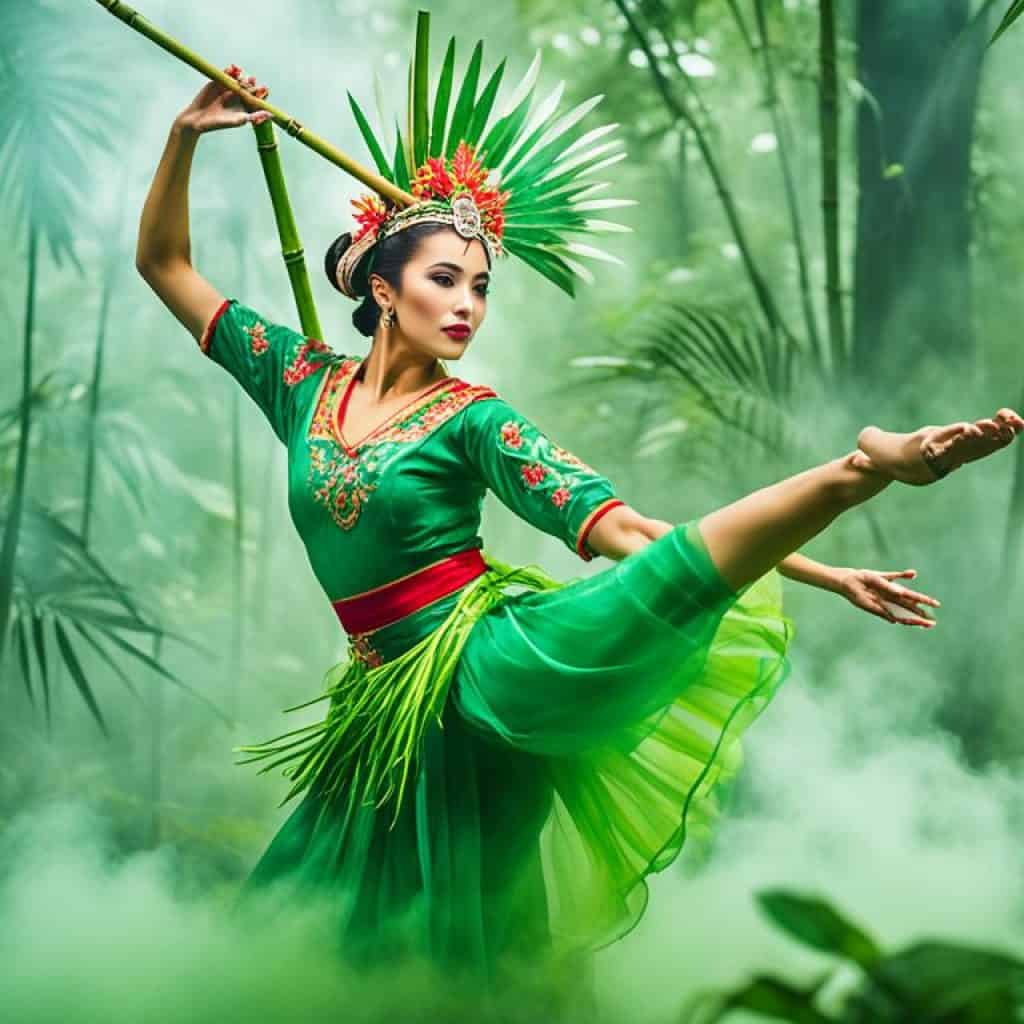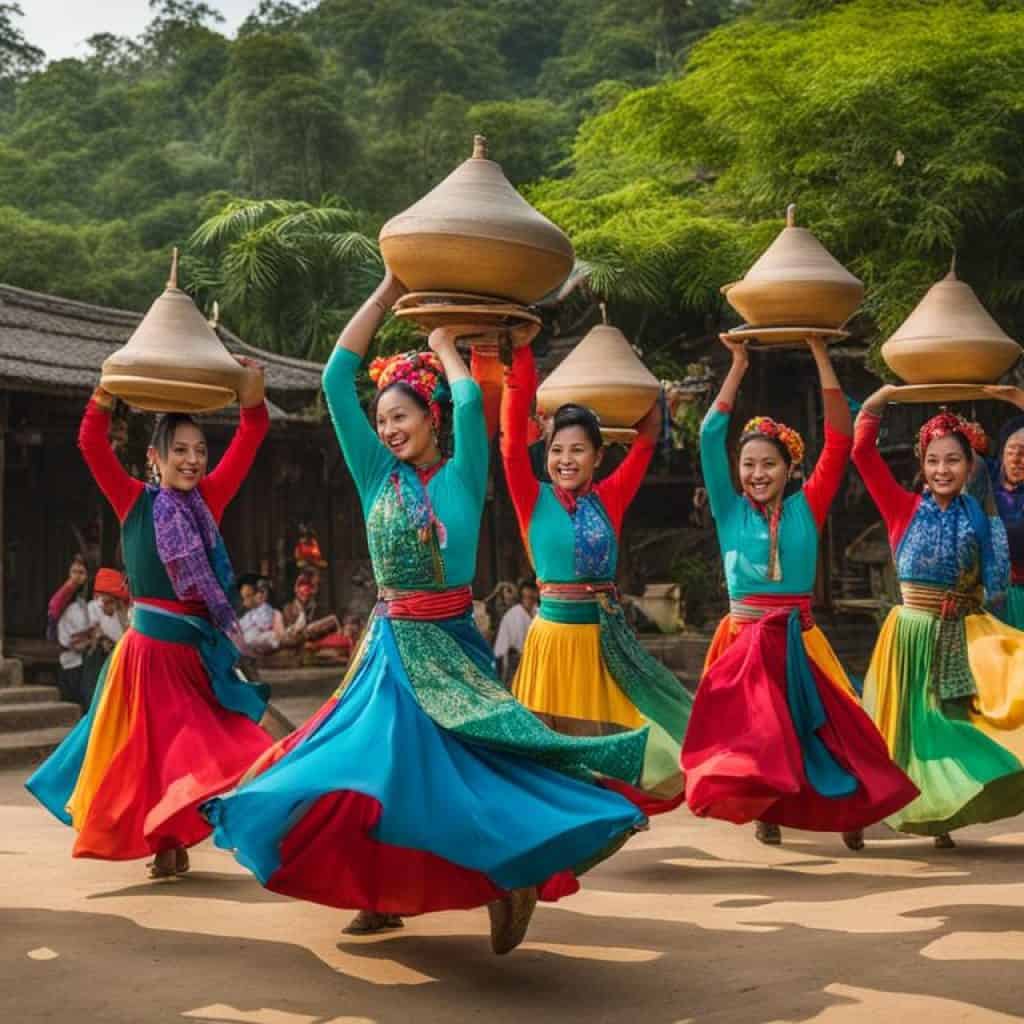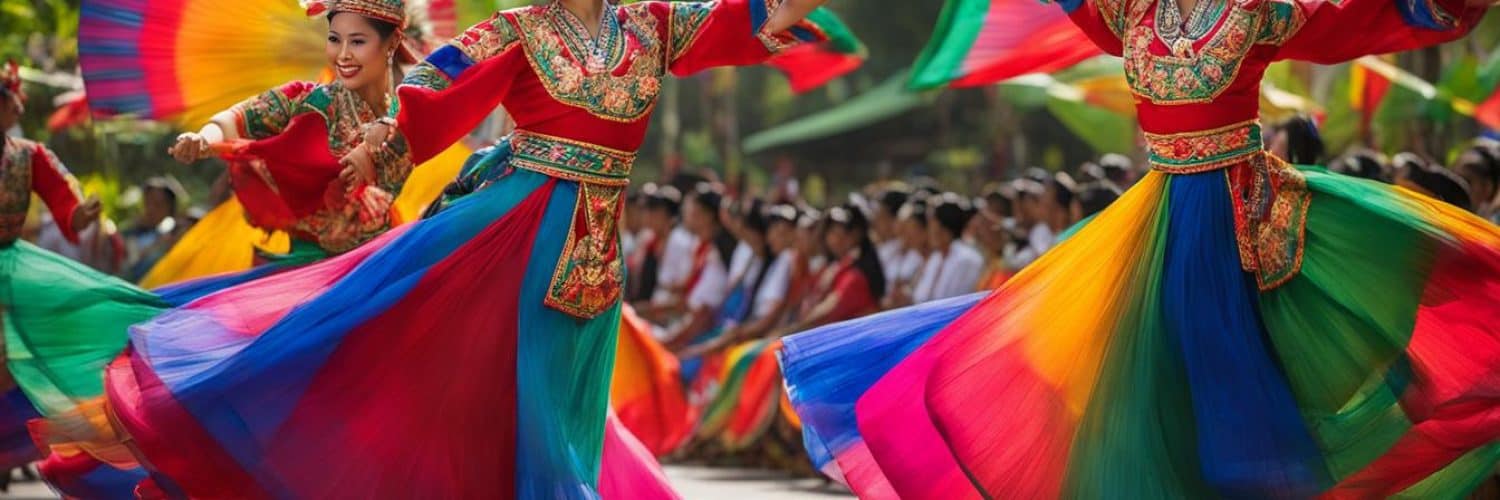The Philippines, a diverse archipelago consisting of over 7,000 islands, is a country rich in cultural heritage and traditions. One aspect that showcases the vibrant tapestry of Filipino culture is its traditional Philippine folk dances. These dances serve as a window into the history, beliefs, and values of the Filipino people. In this article, we will embark on a journey to discover the captivating world of different folk dances in the Philippines.
Key Takeaways:
- Traditional Filipino dances are an important part of the cultural dances in the Philippines.
- Philippine folk dances provide insights into the country’s rich history and cultural traditions.
- There are numerous popular Philippine dances that represent different regions and indigenous communities.
- Preserving and promoting traditional dance forms in the Philippines is crucial for celebrating and honoring the country’s heritage.
- Exploring the diverse traditions of Philippine folk dances allows us to appreciate the beauty and richness of Filipino culture.
Did you know that Filipino folk dances are more than just entertainment? Can you guess how these traditional dance forms in the Philippines reflect the values and beliefs of the Filipino people?
Tinikling â Philippine Folk Dance
Tinikling is often hailed as the national dance of the Philippines and originated from the province of Leyte. It is a dynamic and energetic Philippine folk dance characterized by the rhythmic clashing of bamboo poles. Dancers skillfully maneuver between the poles, representing the movements of the tikling bird. Tinikling embodies the agility, coordination, and teamwork valued in Filipino culture.
| Characteristics | Description |
|---|---|
| Origin | Tinikling originated from the province of Leyte in the Philippines. |
| Dance Style | The dance involves rhythmic clashing of bamboo poles. |
| Inspiration | The movements of tinikling imitate the agility and grace of the tikling bird. |
| Key Elements | Tinikling emphasizes the importance of agility, coordination, and teamwork. |
Experience the mesmerizing movements of Tinikling as dancers gracefully navigate through the rhythmic clashing of bamboo poles, showcasing the agility and coordination cherished in Filipino culture.
Stay tuned as we delve deeper into the captivating world of different folk dances in the Philippines.
Pandanggo sa Ilaw â Philippine Folk Dance
Pandanggo sa Ilaw is a graceful Philippine folk dance that originated in the province of Lubang, Mindoro. This dance is characterized by the performers’ ability to balance oil lamps on their hands and heads while executing intricate footwork with elegance and precision. The name “Pandanggo sa Ilaw” translates to “dance with light” in English, highlighting the central element of illuminated lamps in this captivating performance.
The origins of Pandanggo sa Ilaw can be traced back to the Spanish colonial era, where the culture of the Philippines was significantly influenced by Spanish traditions. This dance bears similarities to the Spanish fandango in terms of its rhythmic and lively movements. The Spanish influence added a layer of elegance and sophistication to the dance, making it a celebration of resiliency and adaptability, which are traits deeply rooted in Filipino culture.
Performers of Pandanggo sa Ilaw demonstrate their agility, balance, and coordination by gracefully maneuvering and manipulating the oil lamps. The dancers’ movements are reminiscent of flickering flames, casting a mesmerizing aura on the stage as they glide and twirl with grace. This folk dance beautifully exemplifies the Filipino people’s ability to embrace external influences and infuse them with their unique cultural expressions.
Just as the dancers navigate and balance the lamps with finesse, the Filipino people have shown remarkable adaptability in merging diverse cultural influences into their own traditions. Pandanggo sa Ilaw is a testament to the Filipinos’ ability to adapt to new ideas while preserving their cultural heritage.
“Pandanggo sa Ilaw is a captivating dance that elegantly showcases the resiliency and adaptability of the Filipino people.”
With each movement and twirl, Pandanggo sa Ilaw captivates audiences with its grace, elegance, and the symbolism of light. This Philippine folk dance serves as a reminder of the enduring spirit of the Filipino people and their ability to embrace change while staying true to their roots.
Singkil â Philippine Folk Dance
Singkil is a captivating Philippine folk dance that originates from the Maranao people of Mindanao. This graceful forest dance tells the tale of the legendary Princess Gandingan as she navigates through a forest filled with swaying bamboo poles.
The Singkil dance is a visual representation of the princess’s escape from danger and her journey to safety. The performers demonstrate remarkable grace, poise, and strong spirit as they skillfully maneuver through the bamboo poles, symbolizing the obstacles she faces along the way.

The Singkil dance is often accompanied by the enchanting sounds of the kulintang, a traditional Muslim musical ensemble. The melody adds an ethereal quality to the performance, enhancing the atmosphere and captivating the audience.
“Singkil brings to life the story of the courageous Princess Gandingan, showcasing the beauty, elegance, and resilience of Filipino women. The dance embodies the grace and poise required to overcome challenges and navigate life’s obstacles with strength and determination.”
The Singkil dance is not only a form of artistic expression but also a celebration of the rich Maranao culture and heritage. It serves as a reminder of the importance of preserving and promoting the traditional dances of the Philippines, ensuring that their legacy continues to inspire and captivate future generations.
Cariñosa â Philippine Folk Dance
Cariñosa is a Philippine folk dance known for its flirtatious and playful movements. Originating from the Panay region, this folk dance is often performed during social gatherings and festivals. Dancers elegantly sway their handkerchiefs while engaging in courtship movements. Cariñosa exemplifies the charm, warmth, and hospitality of the Filipino people and serves as a celebration of love and courtship.
Originating from the Panay region in the Philippines, Cariñosa is a captivating and flirtatious dance that has become popular across the country. It is often performed during social gatherings and festivals, where its enchanting movements and graceful courtship gestures captivate the audience.
The dance is characterized by its playful and engaging choreography, with dancers elegantly swaying their handkerchiefs while executing intricate footwork. The courtship movements in Cariñosa reflect the Filipino tradition of expressing affection through dance, showcasing the Filipino people’s deep appreciation for romance and love.
With every step and gesture, Cariñosa radiates the charm, warmth, and hospitality that are inherent in Filipino culture. The dancers’ fluid movements and delicate interactions evoke a sense of grace and tenderness, creating a captivating atmosphere that celebrates the joy of courtship and the beauty of human connection.
Flirtatious Movements and Courtship Gestures
Cariñosa is a dance that tells a story of courtship, where both the male and female dancers express their affections through graceful movements and charming gestures. The dance begins with the dancers standing apart, teasingly inviting each other to dance with subtle glances and smiles.
As the dance progresses, the dancers mirror each other’s steps, elegantly moving closer together and then gracefully stepping apart. Their body language conveys the tender emotions of courtship, creating an atmosphere of anticipation and romance.
| Dance Element | Description |
|---|---|
| Handkerchief | The dancers elegantly sway their handkerchiefs, using them as an extension of their movements. |
| Courtship Gestures | The dancers engage in charming courtship movements, conveying their affection through graceful motions and subtle interactions. |
| Footwork | The dance incorporates intricate footwork, showcasing the dancers’ agility and precision as they move in sync. |
Cariñosa is a true embodiment of the rich cultural heritage of the Philippines. It showcases the Filipino people’s love for music, dance, and the expression of affection. Through its flirtatious movements, courtship gestures, and elegant footwork, Cariñosa celebrates the beauty of love and courtship in a way that is both charming and mesmerizing.
“Cariñosa is not just a dance; it is a celebration of love, courtship, and the warmth of the Filipino people.”
Whether performed on a grand stage or in a small gathering, Cariñosa brings people together with its charm and infectious energy. It is a testament to the enduring traditions of the Filipino people and a reminder of the importance of love, warmth, and hospitality in our lives.
So, the next time you witness the enchanting dance of Cariñosa, let yourself be captivated by its flirtatious movements and immerse yourself in the celebration of love, courtship, and the rich cultural heritage of the Philippines.
Maglalatik â Philippine Folk Dance
Originating from the province of Rizal, Maglalatik is a lively Philippine folk dance that is frequently performed during the town’s fiestas. This captivating dance showcases a mock battle between two groups: the Moros (Muslims) and the Christians. Maglalatik is a portrayal of the historical struggle faced by the Filipino people against foreign colonizers.
In this energetic dance, dancers are adorned with coconut shell halves attached to their bodies, creating a unique visual spectacle. The dancers engage in rhythmic movements while skillfully striking the coconut shells together. The synchronized strikes and movements of the dancers symbolize the resilience and strength of the Filipino people.
Maglalatik is a testament to the Filipino spirit of resistance and preservation, reflecting the determination to uphold cultural traditions and embrace their heritage. Through this dance, the Filipino people celebrate their history and continue to pass down their culture to future generations.
“Maglalatik is a captivating dance that embodies the struggle of the Filipino people against foreign colonizers.”
The rhythmic beats and lively movements of Maglalatik not only entertain but also educate spectators about Philippine history and the resilience of its people. It serves as a reminder of the struggles faced by the Filipinos throughout history and the importance of preserving their identity and cultural heritage.
Binasuan â Philippine Folk Dance
Hailing from Pangasinan, Binasuan is a captivating Philippine folk dance that showcases the skill and dexterity of its performers. Dancers gracefully balance glasses filled with rice wine on their heads and hands while executing intricate footwork. The fluid movements and coordination required in Binasuan reflect the Filipinos’ ability to maintain balance and adapt to challenges with grace.

Graceful Balance and Fluid Movements
In the Binasuan dance, performers demonstrate their exceptional balance by delicately balancing glasses filled with rice wine on their heads and hands. This remarkable display of control and precision requires a strong sense of coordination.
A Captivating Showcase of Coordination
The Binasuan dance is a true testament to the Filipinos’ ability to synchronize movement and maintain coordination. Dancers seamlessly transition between intricate footwork and the careful balancing act, captivating audiences with their flawless execution.
The fluid movements and coordination required in Binasuan reflect the Filipinos’ ability to maintain balance and adapt to challenges with grace.
The Elegance of Binasuan
Binasuan is renowned for its graceful and flowing movements. Each step and gesture exudes elegance and finesse, making it an enchanting sight to behold. The dancers’ fluidity and grace capture the essence of the Philippine culture and its emphasis on beauty and artistry.
Preserving a Cultural Legacy
Through Binasuan and other traditional Filipino folk dances, the vibrant heritage and rich history of the Philippines are celebrated and preserved. These dances serve as a reminder of the Filipinos’ resilience, creativity, and unwavering spirit.
Itik-Itik â Philippine Folk Dance
Legend has it that the Itik-Itik dance was inspired by a young woman named Kanang, who possessed extraordinary beauty and charm. During a town fiesta, Kanang was asked to dance but was initially hesitant due to her shyness. However, as the music played, she began to mimic the graceful movements of a duck. Her improvised dance captivated the audience, and from then on, her dance style became known as the Itik-Itik dance.
The Itik-Itik dance is a mesmerizing display of grace, agility, and fluidity. Dancers emulate the movements of a duck, gracefully swaying and gliding across the dance floor. This Philippine folk dance not only showcases the natural elegance found in nature but also celebrates the rich cultural heritage of the Filipino people.
As the Itik-Itik dance unfolds, the performers embody the spirit of a duck, effortlessly flowing from one movement to another. Their graceful arm gestures and agile footwork represent the duck’s fluid movements in its natural habitat. Through this dance, the Filipino people pay homage to the wonders of nature and the interconnectedness between humans and the environment.
The Itik-Itik dance is a testament to the creativity and adaptability of the Filipino people. Just as Kanang’s improvised movements became the foundation of this captivating dance, the Itik-Itik dance itself continues to evolve, with dancers infusing their own personal styles and interpretations. This reflects the dynamic and ever-changing nature of Filipino culture.
Itik-Itik Dance Steps
| Step | Description |
|---|---|
| Start | The dance begins with the dancers in a standing position. |
| Imitate a Duck | The dancers mimic the movements of a duck, using arm gestures and footwork to portray the grace and agility of the animal. |
| Fluid Transitions | The dancers smoothly transition from one movement to another, maintaining the fluidity and continuous flow of the dance. |
| Improvise | Similar to how Kanang improvised her movements, dancers are encouraged to add their personal flair and interpretation to the dance. |
| Finish | The dance concludes with a graceful pose, as the dancers embody the spirit of the Itik-Itik. |
The Itik-Itik dance is not only a visual spectacle but also a celebration of the Filipino spirit. It embodies the values of adaptability, creativity, and the appreciation of nature’s beauty. Through this dance, the Filipino people continue to preserve and share their rich cultural heritage with the world.
Pandanggo Oasiwas â Philippine Folk Dance
Pandanggo Oasiwas is a captivating Philippine folk dance that finds its roots in the coastal towns of Ilocos. Originating among the fishing communities, this dance is deeply connected to the natural surroundings of the region.
The dancers of Pandanggo Oasiwas gracefully sway and twirl, embodying the fluidity and beauty of their coastal environment. Their movements depict the mesmerizing sway of the waves and the soaring flight of birds, creating a profound connection between the dancers and their natural surroundings.
This Philippine folk dance serves as a reminder of the harmonious relationship between the Filipino people and nature, celebrating the coastal towns of Ilocos and the vibrant coastal communities that have nurtured this dance for generations.
Kuratsa â Philippine Folk Dance
The origins of Kuratsa can be traced back to the Spanish colonial times, when the Philippines was heavily influenced by European dances such as the waltz and fandango. This graceful Philippine folk dance is a beautiful representation of courtship and mating rituals, drawing inspiration from the movements of the crab.
In Kuratsa, two dancers, a man and a woman, come together to showcase their romantic nature and harmonize with nature’s rhythms. The dance begins with an elegant introductory promenade, setting the stage for the lively and synchronized footwork that follows. The dancers gracefully sway, glide, and turn, perfectly mirroring each other’s movements.
In addition to the footwork, Kuratsa incorporates intricate arm gestures, hand clapping, and playful interactions between the dancers. These elements symbolize the courtship process, reflecting the playful nature of crabs as they court and attract their mates. The dance captures the essence of the Filipino people’s romantic spirit and their deep connection to nature.
Let’s take a closer look at the captivating beauty of Kuratsa with the help of an image:

Kuratsa is not just a dance; it’s a celebration of love, courtship, and the joy of life. Through this enchanting folk dance, the Filipino people pay homage to their rich history, their romantic nature, and the rhythms of nature that surround them.
La Jota Moncadeña â Philippine Folk Dance
La Jota Moncadeña is a lively and energetic Philippine folk dance that takes its name from the town of Moncada in Tarlac province. This traditional dance is characterized by intricate footwork, intricate turns, and graceful arm movements, which are accentuated by the use of castanets known as “palillos”.
The dancers of La Jota Moncadeña exhibit a remarkable synchronization as they move in pairs or groups, forming intricate formations such as circles or lines. The choreography emphasizes the grace and lively interactions between the dancers, creating a spirited and captivating performance.
The lively movements and intricate footwork of La Jota Moncadeña showcase the rich cultural heritage of the Tarlac province. With its energetic and graceful execution, this dance enthralls both performers and audience alike, celebrating the vibrant traditions of the Filipino people.
| Key Features | Description |
|---|---|
| Lively and Energetic Movements | The dance is characterized by lively and energetic movements, showcasing the vibrancy and liveliness of the performers. |
| Intricate Footwork | The dancers demonstrate intricate footwork, executing precise and detailed steps that require skill and agility. |
| Castanets | The use of castanets called “palillos” adds an additional layer of rhythm and sound to the performance. |
| Synchronization | The dancers exhibit a high level of synchronization, moving in harmony with one another to create a visually pleasing performance. |
| Graceful Interactions | The choreography emphasizes lively interactions between dancers, creating a sense of connection and engagement. |
Kappa Malong-Malong â Philippine Folk Dance
Kappa Malong-Malong is a vibrant and culturally significant Philippine folk dance that originated in the indigenous communities of Mindanao. This captivating dance showcases the beauty and tradition of the malong, a tubular garment worn by various indigenous groups such as the Maranao, Maguindanao, T’boli, and Yakan. The malong holds deep cultural significance, representing identity, tradition, and pride within these communities.
In Kappa Malong-Malong, dancers, both male and female, skillfully wrap the malong around their bodies, creating a flowing and colorful ensemble that adds to the visual spectacle of the performance. The malong’s intricate patterns and vibrant colors serve as a visual representation of the rich cultural heritage of the indigenous people of Mindanao.
This Philippine folk dance is characterized by graceful arm gestures and intricate footwork, which adds to the overall fluidity of the performance. The dancers’ movements mirror the versatility and fluidity of the malong itself, creating a mesmerizing display of coordination and artistry.
The Kappa Malong-Malong dance is a celebration of indigenous culture and serves as a reminder of the importance of preserving and promoting traditional folk dances. Through this dance, the indigenous communities of Mindanao honor their heritage, share their stories, and strengthen their cultural identity.
By embracing and learning about the cultural significance of Kappa Malong-Malong and other Philippine folk dances, we can appreciate the beauty of diversity and foster a deep sense of appreciation for the traditions that have been passed down through generations.
Traditional Garments of Indigenous Communities in Mindanao:
| Indigenous Group | Traditional Garment |
|---|---|
| Maranao | Malong |
| Maguindanao | Malong |
| T’boli | T’nalak |
| Yakan | Malong |
Conclusion
The traditional Philippine folk dances are a cherished part of the country’s cultural heritage, representing a vibrant culture with diverse traditions and a rich history. These dances embody the spirit and values of the Filipino people, showcasing their grace, resilience, and strong connection to their roots.
It is crucial to preserve and promote these folk dances so that future generations can fully appreciate and celebrate the beauty and significance they hold. By learning and participating in these dances, we contribute to the preservation of our cultural heritage and ensure that it continues to thrive.
Through the preservation and promotion of Philippine folk dances, we celebrate our vibrant culture and honor the diverse traditions that make us unique. These dances serve as a window into our past, allowing us to connect with our roots and understand our identity as Filipinos. Let us continue to embrace and share these captivating folk dances, passing down their legacy to inspire and enrich the future generations of our beloved country.
FAQ
What are traditional Filipino dances?
Traditional Filipino dances are cultural dances in the Philippines that showcase the vibrant tapestry of Filipino culture. These dances reflect the history, beliefs, and values of the Filipino people.
What is the national dance of the Philippines?
The national dance of the Philippines is Tinikling, a dynamic and energetic Philippine folk dance that originated from the province of Leyte. It involves the rhythmic clashing of bamboo poles and represents the movements of the tikling bird.
Which Philippine folk dance reflects Spanish influence?
Pandanggo sa Ilaw is a graceful Philippine folk dance that reflects Spanish influence. It originated in the province of Lubang, Mindoro, and is characterized by performers balancing oil lamps on their hands and heads while executing intricate footwork.
What is the significance of Singkil in Filipino culture?
Singkil is a Philippine folk dance that hails from the Maranao people of Mindanao. It tells the tale of the legendary Princess Gandingan as she gracefully navigates through a forest filled with swaying bamboo poles. Singkil embodies the grace, poise, and strong spirit of a Filipino woman.
What is the meaning of Cariñosa in the Philippines?
Cariñosa is a flirtatious and playful Philippine folk dance that is often performed during social gatherings and festivals. Originating from the Panay region, Cariñosa showcases the charm, warmth, and hospitality of the Filipino people and serves as a celebration of love and courtship.
What historical event does Maglalatik symbolize?
Maglalatik is a lively Philippine folk dance originating from the province of Rizal and is often performed during town fiestas. It depicts a mock battle between two groups: the Moros (Muslims) and the Christians. Maglalatik symbolizes the historical struggle between the Filipino people and foreign colonizers.
What is the specialty of Binasuan in Philippine folk dance?
Binasuan is a captivating Philippine folk dance originating from Pangasinan. It features dancers gracefully balancing glasses filled with rice wine on their heads and hands while executing intricate footwork. The dance showcases the skill, dexterity, and grace of its performers.
What is the story behind the Itik-Itik dance?
Itik-Itik dance was inspired by a young woman named Kanang, who mimicked the graceful movements of a duck during a town fiesta in the Philippines. Her improvised dance captivated the audience, and from then on, her dance style became known as the Itik-Itik dance.
What does Pandanggo Oasiwas represent in Philippine culture?
Pandanggo Oasiwas, which originates from the coastal towns of Ilocos, represents the gentle movements of ocean waves and the grace of birds in flight. It reflects the close connection between the Filipino people and their natural surroundings.
What does Kuratsa symbolize in Philippine folk dance?
Kuratsa, a Philippine folk dance with origins in Spanish colonial times, symbolizes the courtship and mating rituals of the crab. It showcases the romantic nature of the Filipino people and their connection to nature’s rhythms.
What is the appeal of La Jota Moncadeña in Philippine folk dance?
La Jota Moncadeña, originating from the town of Moncada in Tarlac province, is characterized by lively and energetic movements, intricate footwork, and graceful arm movements. The dance emphasizes synchronization, grace, and lively interactions between dancers.
What is the significance of the malong in Kappa Malong-Malong?
Kappa Malong-Malong, originating in the indigenous communities of Mindanao, incorporates the malong, a tubular garment with deep cultural significance. The dance features dynamic movements and vibrant costumes, reflecting the fluidity of the malong and the cultural pride of the Filipino people.
What is the importance of preserving Philippine folk dances?
Philippine folk dances are a significant part of the country’s cultural heritage. Preserving these dances helps promote and celebrate the rich history, traditions, and diverse culture of the Filipino people for future generations.


















Add comment